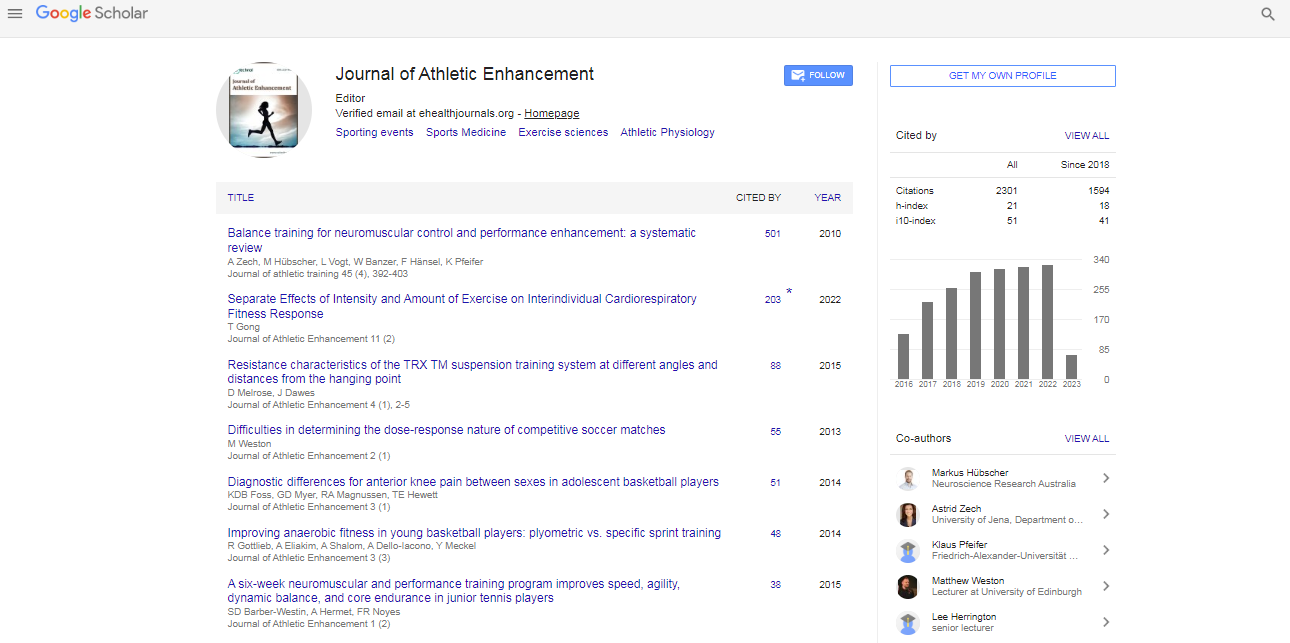Commentary, J Athl Enhanc Vol: 13 Issue: 4
Foundations of Athletic Physiology: Understanding the Science of Sport Performance
Barbara Bateman*
Department of Sports, Michigan State University, East Lansing, United States of America
*Corresponding Author: Barbara Bateman,
Department of Sports, Michigan State University, East Lansing,
United States of America;
E-mail: batemanbarbara@msu.edu
Received date: 28 June, 2024, Manuscript No. JAE-24-144880;
Editor assigned date: 01 July, 2024, PreQC No. JAE-24-144880 (PQ);
Reviewed date: 15 July, 2024, QC No. JAE-24-144880;
Revised date: 22 July, 2024, Manuscript No. JAE-24-144880 (R);
Published date: 29 July, 2024, DOI: 10.4172/2324-9080.1000133
Citation: Bateman B (2024) Foundations of Athletic Physiology: Understanding the Science of Sport Performance. J Athl Enhanc 13:4.
Description
Athletic physiology is the branch of science that studies how the body responds to exercise and physical training. This field combines principles from biology, anatomy, physiology and sports science to understand how physical activity affects the body’s systems and how individuals can optimize their performance through training, nutrition and recovery. Athletic physiology is integral to developing effective training programs, enhancing athletic performance and preventing injuries.
The basis of athletic physiology
Athletic physiology examines how physical activity impacts the body's various systems, including the muscular, cardiovascular, respiratory and endocrine systems. At its core, it focuses on understanding the adaptations that occur in response to exercise and the way these adaptations contribute to improved the performance and overall health.
Muscular system: When engaging in physical activity, muscles undergo stress, which stimulates the repair and growth of muscle fibers. This process, known as hypertrophy, enhances muscle strength and endurance. Different types of exercise resistance training, aerobic exercise and flexibility training target various muscle groups and contribute to overall fitness. Resistance training, for instance, builds muscle mass and strength, while aerobic exercises improve cardiovascular endurance and overall stamina.
Cardiovascular system: Exercise challenges the cardiovascular system, which includes the heart, blood vessels and blood. Regular physical activity improves heart efficiency, increases cardiac output and enhances blood flow. These adaptations help reduce the risk of cardiovascular diseases and improve overall cardiovascular health. For athletes, a well-trained cardiovascular system supports better oxygen delivery to working muscles and more efficient removal of metabolic waste products.
Respiratory system: The respiratory system works closely with the cardiovascular system to ensure efficient oxygen uptake and carbon dioxide removal during exercise. Training can improve lung capacity and respiratory muscle strength, which enhances an athlete's ability to perform at high intensities and recover more quickly. This adaptation is particularly important for endurance athletes who rely on optimal oxygen utilization.
Endocrine system: Exercise stimulates the release of various hormones, including adrenaline, cortisol and growth hormone. These hormones play important roles in energy production, muscle repair and adaptation to training.
Training adaptations and performance
Training induces specific adaptations in the body that contribute to improved athletic performance. These adaptations include:
Muscular adaptations: Regular exercise leads to changes in muscle fibers, including increased cross-sectional area, enhanced enzymatic activity and improved neuromuscular efficiency. These adaptations result in greater strength, power and endurance.
Cardiovascular adaptations: Long-term endurance training enhances the heart's ability to pump blood efficiently, increases capillary density in muscles and improves the ability of muscles to extract and utilize oxygen. These adaptations lead to improved aerobic capacity and endurance.
Metabolic adaptations: Exercise influences the body’s ability to metabolize nutrients and generate energy. Training enhances the efficiency of energy production pathways, including aerobic and anaerobic systems, allowing athletes to sustain high-intensity efforts and recover more rapidly.
Psychological adaptations: Regular physical activity also impacts mental and emotional well-being. Exercise has been shown to improve mood, reduce stress and enhance cognitive function, which can positively influence athletic performance and overall quality of life.
Injury prevention and recovery
Understanding athletic physiology is important for injury prevention and effective recovery. Training programs must be designed to balance exercise intensity, volume and rest to prevent overtraining and injury. Key components include:
Proper warm-up and cool-down: Warming up before exercise prepares the body for physical activity by increasing blood flow to muscles and improving joint flexibility.
Recovery strategies: Recovery is a critical aspect of training. Adequate rest, nutrition and hydration support muscle repair and adaptation. Techniques such as stretching, massage and foam rolling can aid in reducing muscle soreness and enhancing recovery.
Injury prevention: Strengthening exercises, proper technique and cross-training can help prevent injuries by improving muscle balance and joint stability. Athletes should also be educated about proper equipment use and techniques to reduce the risk of acute and chronic injuries.
 Spanish
Spanish  Chinese
Chinese  Russian
Russian  German
German  French
French  Japanese
Japanese  Portuguese
Portuguese  Hindi
Hindi 
